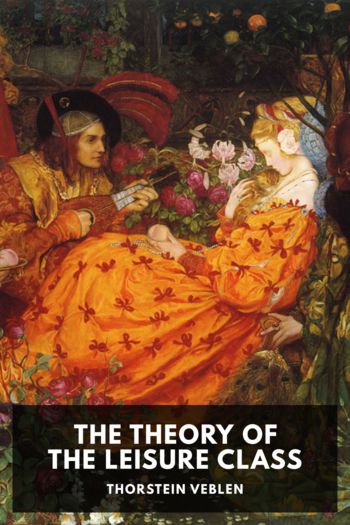The Theory of the Leisure Class - Thorstein Veblen (english books to improve english txt) 📗

- Author: Thorstein Veblen
Book online «The Theory of the Leisure Class - Thorstein Veblen (english books to improve english txt) 📗». Author Thorstein Veblen
The position here taken is enforced in a felicitous manner by the place assigned in the economy of consumption to machine products. The point of material difference between machine-made goods and the hand-wrought goods which serve the same purposes is, ordinarily, that the former serve their primary purpose more adequately. They are a more perfect product—show a more perfect adaptation of means to end. This does not save them from disesteem and deprecation, for they fall short under the test of honorific waste. Hand labor is a more wasteful method of production; hence the goods turned out by this method are more serviceable for the purpose of pecuniary reputability; hence the marks of hand labor come to be honorific, and the goods which exhibit these marks take rank as of higher grade than the corresponding machine product. Commonly, if not invariably, the honorific marks of hand labor are certain imperfections and irregularities in the lines of the hand-wrought article, showing where the workman has fallen short in the execution of the design. The ground of the superiority of hand-wrought goods, therefore, is a certain margin of crudeness. This margin must never be so wide as to show bungling workmanship, since that would be evidence of low cost, nor so narrow as to suggest the ideal precision attained only by the machine, for that would be evidence of low cost.
The appreciation of those evidences of honorific crudeness to which hand-wrought goods owe their superior worth and charm in the eyes of well-bred people is a matter of nice discrimination. It requires training and the formation of right habits of thought with respect to what may be called the physiognomy of goods. Machine-made goods of daily use are often admired and preferred precisely on account of their excessive perfection by the vulgar and the underbred who have not given due thought to the punctilios of elegant consumption. The ceremonial inferiority of machine products goes to show that the perfection of skill and workmanship embodied in any costly innovations in the finish of goods is not sufficient of itself to secure them acceptance and permanent favor. The innovation must have the support of the canon of conspicuous waste. Any feature in the physiognomy of goods, however pleasing in itself, and however well it may approve itself to the taste for effective work, will not be tolerated if it proves obnoxious to this norm of pecuniary reputability.
The ceremonial inferiority or uncleanness in consumable goods due to “commonness,” or in other words to their slight cost of production, has been taken very seriously by many persons. The objection to machine products is often formulated as an objection to the commonness of such goods. What is common is within the (pecuniary) reach of many people. Its consumption is therefore not honorific, since it does not serve the purpose of a favorable invidious comparison with other consumers. Hence the consumption, or even the sight of such goods, is inseparable from an odious suggestion of the lower levels of human life, and one comes away from their contemplation with a pervading sense of meanness that is extremely distasteful and depressing to a person of sensibility. In persons whose tastes assert themselves imperiously, and who have not the gift, habit, or incentive to discriminate between the grounds of their various judgments of taste, the deliverances of the sense of the honorific coalesce with those of the sense of beauty and of the sense of serviceability—in the manner already spoken of; the resulting composite valuation serves as a judgment of the object’s beauty or its serviceability, according as the valuer’s bias or interest inclines him to apprehend the object in the one or the other of these aspects. It follows not infrequently that the marks of cheapness or commonness are accepted as definitive marks of artistic unfitness, and a code or schedule of aesthetic proprieties on the one hand, and of aesthetic abominations on the other, is constructed on this basis for guidance in questions of taste.
As has already been pointed out, the cheap, and therefore indecorous, articles of daily consumption in modern industrial communities are commonly machine products; and the generic feature of the physiognomy of machine-made goods as compared with the hand-wrought article is their greater perfection in workmanship and greater accuracy in the detail execution of the design. Hence it comes about that the visible imperfections of the hand-wrought goods, being honorific, are accounted marks of superiority in point of beauty, or serviceability, or both. Hence has arisen that exaltation of the defective, of which John Ruskin and William Morris were such eager spokesmen in their time; and on this ground their propaganda of crudity and wasted effort has been taken up and carried forward since their time. And hence also the propaganda for a return to handicraft and household industry. So much of the work and speculations of this group of men as fairly comes under the characterization here given would have been impossible at a time when the visibly more perfect goods were not the cheaper.
It is of course only as to the economic value of this school of aesthetic teaching that





Comments (0)